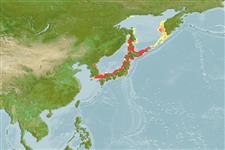Common names from other countries
分类 / Names
俗名 | 同种异名 | Catalog of Fishes(属, 种) | ITIS | CoL | WoRMS | Cloffa
Teleostei >
Salmoniformes (Salmons) >
Salmonidae (Salmonids) > Salmoninae
Etymology: Oncorhynchus: Greek, onyx, -ychos = nail + Greek, rhyngchos = snout (Ref. 45335).
Environment: milieu / climate zone / depth range / distribution range
生态学
海洋; 淡水; 半咸淡水 底中水层性; 溯河洄游 (Ref. 51243); 深度上下限 0 - 200 m (Ref. 50550). 溫帶; 65°N - 34°N, 127°E - 158°E
Northwest Pacific: Japan and adjacent waters.
西北太平洋: 鄂霍次克海與日本海; 日本北部與韓國半島東部。
大小 / 重量 / 年龄
Maturity: Lm ? range ? - ? cm
Max length : 79.0 cm TL 雄鱼/尚未辨别雌雄; (Ref. 56527); 最大体重: 10.0 kg (Ref. 9988)
The fluviatile form generally inhabits headwaters and often maintains a territory; it feeds mainly on insects but also on small crustaceans and fishes. The sea-run form goes downstream forming schools, and after a short stay in the brackish zone enters the sea where it feeds on small fishes and pelagic crustaceans. Oviparous (Ref. 205). Eggs are buried in unguarded nests (Ref. 205). Marketed fresh and frozen; eaten broiled and baked (Ref. 9988).
生活在河中的形式通常居住于河川源头而且时常维持领土; 它主要捕食昆虫也捕食小型甲壳动物与鱼。 海洋回游的形式去向下游形成群体, 而且在一个短停留在中之后,半咸淡的区域进入海洋在哪里它吃小鱼与大洋性甲壳动物。 卵生的.(参考文献 205) 卵被埋藏在没有防卫的巢之中。 (参考文献 205) 在市场上销售生鲜和冷冻; 吃火烤与烧烤的.(参考文献 9988)
Distinct pairing (Ref. 205). Reproductive strategy: synchronous ovarian organization, determinate fecundity (Ref. 51846).西北太平洋: 鄂霍次克海與日本海; 日本北部與韓國半島東部。
Masuda, H., K. Amaoka, C. Araga, T. Uyeno and T. Yoshino, 1984. The fishes of the Japanese Archipelago. Vol. 1. Tokai University Press, Tokyo, Japan. 437 p. (text). (Ref. 559)
世界自然保护联盟红皮书 (Ref. 130435)
濒危 (A1ac; B2abcde+3abd); Date assessed: 01 August 1996
CITES (Ref. 128078)
Not Evaluated
人类利用
渔业: 商业性; 养殖: 商业性; 游钓鱼种: 是的
工具
特别资料
下载 XML
网络资源
Estimates based on models
Preferred temperature (Ref.
115969): 0.3 - 16.5, mean 3.3 (based on 86 cells).
Phylogenetic diversity index (Ref.
82804): PD
50 = 0.5000 [Uniqueness, from 0.5 = low to 2.0 = high].
Bayesian length-weight: a=0.00955 (0.00605 - 0.01506), b=3.03 (2.90 - 3.16), in cm Total Length, based on LWR estimates for this species & Genus-body shape (Ref.
93245).
营养阶层 (Ref.
69278): 3.6 ±0.59 se; based on food items.
回复力 (Ref.
120179): 中等的, 族群倍增时间最少 1.4 - 4.4年 (tm=4; tmax=6; Fec=1,000).
Fishing Vulnerability (Ref.
59153): Moderate to high vulnerability (52 of 100).
Climate Vulnerability (Ref.
125649): Moderate to high vulnerability (49 of 100).
